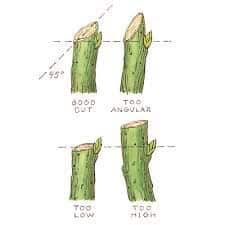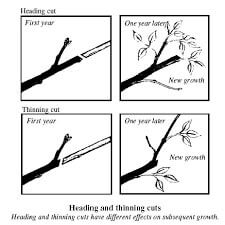
Tree and Shrub Care
It’s never been easier to have a beautiful lawn. Call today to lock in your savings!
Monday – Friday: 8:30am to 5:30pm EST
Saturday: 9:00am to 2:00pm EST
Opt into our text messaging platform to begin your program and schedule with us today!

You can partly determine the characteristic shape and size of a woody plant and its response to pruning by the plant’s natural pattern of shoot growth. When a seed germinates and grows, only one growing point exists, the apex or terminal bud. When a terminal bud begins growing after being dormant, it leaves a bud scale scar on the branch. You can use the scars to determine the age of a limb or tree by counting the scars. As the new shoot elongates, structures called nodes are formed. A node is the area on the shoot where a leaf is attached. One to three lateral buds are produced at each of these nodes. Growth of lateral buds is directed by the terminal bud, which produces a hormone called auxin. Auxin moves downward in the shoot from the shoot apex and inhibits the growth and development of lateral buds.
The intensity of apical dominance varies from one plant species to another. Some plants suppress the growth of their lateral buds until the second growing season, while others develop both lateral shoots and terminal buds during the first growing season. Apical dominance influences the number of shoot-forming lateral buds, the lengths of lateral shoots formed, and the angle at which the shoots emerge from the main limb. The orientation of a limb or shoot along the main branch has a major influence on growth by its effect on apical dominance. Because auxin moves downward in the shoot toward the Earth’s center, apical dominance is strongest in vertical or upright shoots or limbs. In vertical limbs, vigorous shoot growth occurs near the terminal bud with lateral shoots becoming more sparse with increasing distance from the apex

On the other hand, orientation of lateral branches at 45° to 60° angles from the vertical or main shoot reduces the vigor of shoot growth near the apex and increases the number and length of laterals along the limb further from the apex. On horizontal limbs, apical dominance is totally lost. Without apical dominance to control their growth, lateral buds on the upper side of horizontal limbs develop into vigorous, upright shoots, called water sprouts. As they develop, water sprouts show very strong apical dominance. Water sprouts are a common problem on the upper surface of flat limbs in fruit trees and are removed by pruning.

Real Green Pest and LawnThere are two basic types of pruning cuts, heading and thinning. Heading removes the terminal portion of shoots or limbs. By removing apical dominance, heading stimulates growth near the cut. It also is the most invigorating type of pruning cut, resulting in thick compact growth and a loss of natural form, as in the case of a formally pruned hedge. Sometimes ornamental shrubs along a foundation overgrow their planting space and are rejuvenated by heading to within 12 inches of ground level. Thinning removes an entire shoot or limb to its point of origin from the main branch or lateral. Some shoot tips are left undistributed, so apical dominance is maintained. As a result, new growth occurs at the undisturbed shoot tips while lateral bud development and growth is suppressed. Thinning is generally the least invigorating type of pruning cut and provides a more natural growth form of plants. Important in maintenance pruning, thinning cuts are used to shorten limbs, to improve light penetration into plants and to direct the growth of shoots or limbs.
Drop-crotching, a form of thinning used to reduce the size of large trees, involves the removal of a main branch by cutting it back to a large, lateral branch. The cut through the main branch is made parallel to the angle of the remaining lateral. When removing large tree limbs, a series of three cuts are recommended in order to avoid tearing the bark along the main truck and severely wounding the tree. One undesirable form of thinning is the bench cut, where a vigorous upright limb is thinned to horizontal limb. Vigorous, upright shoot growth, called water sprouts, often result from the “bench” area because of the absence of apical dominance in the horizontal limb. The correct method is to make the thinning cuts to limbs that are similar in angle to the limb being removed but not more than 45° to 60° from vertical. Shoots or limbs having narrow-angled crotches are weaker than those having wide crotch angles. The bark of the adjoining branches becomes tightly compressed, preventing normal wood development. Winter ice, trapped down in crotches, often causes narrow-angled branches to split.

Time of pruning varies with plant species. Prune at times that best complement the growth characteristics and flowering. Many woody ornamentals are pruned according to their date of flowering. Pruning spring-flowering shrubs during the dormant season will remove flower buds formed the previous fall. Summer-flowering plants generally are pruned during the dormant winter season. If plants are not grown for their flowers, the best time for pruning is during the dormant winter season before new growth begins in the spring. Avoid heavy pruning during the late summer and fall because growth may occur and make the plants more susceptible to cold injury. Some plants bleed heavily after pruning, which doesn’t hurt them. Trees subject to bleeding should be pruned in the late spring or early summer when leaves are on the tree. Actively growing leaves tend to reduce the amount of bleeding from pruning cuts and let the cuts heal faster.
Pruning is an invaluable tool for developing and maintaining woody plants. Developing clear pruning objectives is important. By combining these objectives with a basic understanding of pruning and how plants respond, you can derive maximum benefit from the effort. To summarize:
Acknowledgment is made to Dr. Stephen C. Myers for developing the original manuscript for this publication.
Bulletin 949/Revised April 1999
The University of Georgia and Ft. Valley State University, the U.S. Department of Agriculture and counties of the state cooperating. The Cooperative Extension Service, the University of Georgia College of Agricultural and Environmental Sciences offers educational programs, assistance and materials to all people without regard to race, color, national origin, age, sex or disability.
An Equal Opportunity Employer/Affirmative Action Organization Committed to a Diverse Work Force
Issued in furtherance of Cooperative Extension work, Acts of May 8 and June 30, 1914, The University of Georgia College of Agricultural and Environmental Sciences and the U.S. Department of Agriculture cooperating.
Gale A. Buchanan, Dean and Director

Contact Real Green Services today to ensure a healthy and thriving lawn.
Free Quote